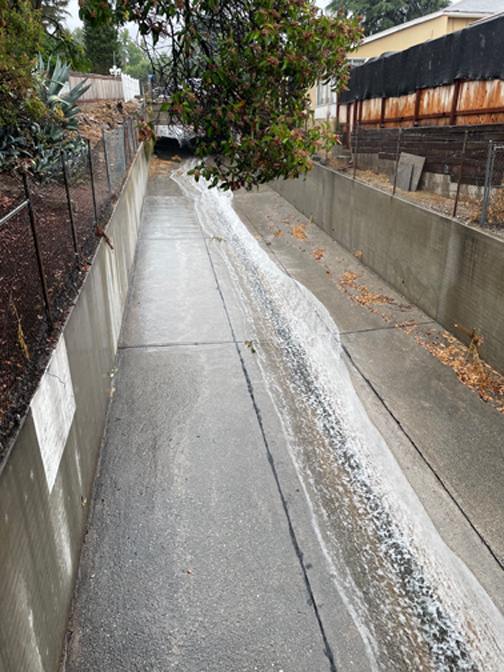
Photo by Mary O’KEEFE
That’s A Wrap
Although everyone was ready for the worst, residents in the local area – from Burbank to La Cañada Flintridge – considered themselves lucky after the first tropical storm in over 80 years made its way across Southern California.
By Mary O’KEEFE
Hurricane Hilary was downgraded to a tropical storm by the time it reached California. During its stay it dropped a lot of rain from the mountains to the valleys.
The brunt of the storm was felt in low desert areas like Palm Springs, Cathedral City and Coachella Valley. Areas in San Bernardino were still under evacuation notice as of Aug. 22. Ten people had been trapped due to the overflow from the rain and one person, a 75-year-old retired school district worker, is still reported missing in the Seven Oaks area.
For the local area, though, it was more about the rain than anything else. The rain totals are impressive: According to the National Oceanic and Atmospheric Agency (NOAA), La Cañada Flintridge received 4.54 inches of rain, Santa Anita Dam 6.53 inches, Burbank 3.56 inches, Pasadena 4.33 inches, East Pasadena 5.75 inches, Hansen Dam 2.29 and Eagle Rock Reservoir saw 4.71 inches.
According to City of Glendale spokesperson Stephanie Mkhlian, Glendale Water and Power crews responded to four large feeder outages throughout the City. A total of 8,900 customers were out of power due to the outages. Three of the outages were caused by equipment issues, such as a transformer fire, and two were at substations; one was caused by a wire down due to falling palm fronds. The power was restored to most customers within an hour, but some were out of power for two to four hours.
From midnight Aug. 20 to midnight Aug. 21, Glendale Fire Dept. responded to 101 incidents – 97 in Glendale, three in Burbank and one in Los Angeles County. For comparison, the previous Sunday GFD responded to 61 incidents – 58 in Glendale, two in Burbank and one in LA County. One of the responses concerned a mudslide in the 800 block of Cavanaugh Road in Glendale.
According to Sgt. Victor Jackson of the GPD, most of the issues from the storm were due to downed trees and branches, and another mudslide in the 3400 block of Linda Vista.
In the unincorporated area of LA County-La Crescenta Montrose, the LA County Sheriff Dept.-Crescenta Valley Station did not have any reported issues due to the storm, according to Sgt. John Gilbert.
“There were no calls of any significance due to the storm; however, there was a slight increase in the volume of calls, which we experienced throughout the County. Typically, we respond to an average of two calls per day in the Crescenta Valley. On Sunday, we responded to a total of six calls,” said Maria Grycan, LA County Fire Dept. spokesperson.
LACoFD responded to a structure fire in the 2300 block of Panorama Street in La Crescenta about 2 p.m. on Sunday. The fire was not a result of the storm.
LA County and LA City were very prepared for the storm as was the LA County Dept. of Public Works (DPW).
“We had crews pre-mobilized,” said Steven Frasher, DPW spokesperson.
The crews were positioned in areas they expected problems, including the area of the 2020 Bobcat Fire, and in Malibu.
LA County Supervisor Janice Hahn publicized 211 LA, which is a hub for community members and organizations looking for health, human and social services. Frasher said that service helped guide people to numbers they could call to report various issues.
Crews were out and immediately responded to calls for service that included clearing out catch basins and cleaning debris from streets including rockslides on the Angeles Crest Highway.
This storm allowed LA County to capture even more rain runoff. The rainfall capture was 283% above average prior to the storm. There are several rainfall capture systems – drain and infiltration systems, like the one in Sun Valley, and a storm drain system along Cantara Street.
“We captured 1.4 billion gallons of runoff [water] for this storm,” Frasher said.
He emphasized that though these water capture numbers are high this is not the “new normal;” dry conditions will return and everyone needs to continue to conserve.
